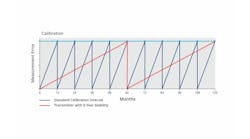“The edge is really the best of both worlds, reducing the downsides of each.” Rockwell Automation’s Oliver Haya discussed the importance of edge computing in bridging local and cloud platforms, and previewed the company’s new FactoryTalk Edge Gateway.
Local computing is where many operational technology (OT) professionals are most comfortable. Doing it all right there on the plant floor with PCs and laptops and servers. That approach works, of course, but it has limitations as we advance to connecting systems and sending data to the cloud. Also, the local approach makes it almost impossible to share data with vendors.
Cloud computing overcomes those hurdles and makes transporting data easier, but connecting to the cloud can be tricky in some OT environments. Cloud computing with massive data sets can grow costly, too.
Enter edge computing, which in the parlance of Oliver Haya straddles the line between local and cloud computing. With edge computing you are working closer to your equipment, which reduces latency. There is built-in security with (smart) edge-computing approaches. And edge enables easier transport of data and applications to OT.
“The edge is really the best of both worlds, reducing the downsides of each,” summed the Rockwell Automation commercial product manager during his ROKLive presentation, “Growing, Scaling and Managing the Industrial Edge,” in which he announced the fall 2022 launch ofRockwell’s new FactoryTalk Edge Gateway, a software-as-a-service package designed to scale industrial edge uses to make it easier for industrial professionals to quicken their digital transformations while capitalizing on new software capabilities.
The capacity crowd in the room was intrigued. Haya explained how FactoryTalk Edge is an intelligent, centralized edge-management infrastructure solution that is accessible as a single sign-on with other Rockwell Automation software-as-a-service (SaaS) products. It addresses edge-computing use cases from the top floor to the shop floor across the cloud, plant and line levels. Users can reduce their total cost of ownership with faster time to value, enhanced productivity, and reduced maintenance needs all while future-proofing their business with this managed edge solution.
The audience peppered the presenter with questions about specific uses of this new tool. Haya provided big-picture context for its creation and industry-specific examples of its capabilities.
Applications proliferating
The presenter noted a sea change over the past few years regarding edge use. “People see the potential for IT/OT convergence with the edge,” he said, focusing on OT operations managed by IT teams. “There are real challenges for OT with cloud latency and the cost of connectivity. Moving to the cloud has been slower for OT, but that will accelerate because of the edge.”
And while there is growing recognition among industrial professionals about how the edge can benefit their operations, Haya stressed the need to consider the what. “If you are going to build an edge strategy, you have to consider what you are going to do with it,” he said as heads in the audience nodded. Are more granular analytics the goal? Do you want to run your MES better? Are you seeking greater visualization of your platforms? Is your answer yes and yes and yes and more?
“There are a lot of good reasons for an edge approach, but you have to determine the specific value for you and your business,” noted Haya. “That will inform your roadmap of applications and your edge strategy. And then you have to lean in.”
Lean in?
What the presenter means is that successful edge strategies exploit their distributed and modular nature. He explained how users should launch this approach with “an edge per machine or per line.” The more users commit to the edge—they more they lean in—the more rewards they will reap.
And users need a network that can support that full commitment, particularly as the number of edge devices and the number of affiliated apps expands. “Here we can add a ton of value with the solution we’re bringing,” Haya crowed, touting FactoryTalk Edge’s ability to provide managed services to more easily roll out edge efforts. He explained the solution’s ability to future-proof campaigns to determine what users don’t know about their operations, and the ability to study modular systems within an industrial architecture and add appropriate elements over time.
Perhaps most critically, the Rockwell solution enables these gains to be made securely. During this presentation Haya referenced a Gartner stat that, by 2025, 25% of edge networks will be breached as enterprises continue to converge IT and OT. “If you don’t have new security with your new edge solution you are creating a new hole, a new attack vector,” he warned, noting how FactoryTalk Edge was designed from the beginning with security in mind. “Any time you can enhance your security posture, that is worthwhile.”
Users are invited to build their own applications to work alongside a rich ecosystem of applications native to FactoryTalk Edge. They are encouraged to test the full capabilities of the flexibility and modularity of the solution. And they were reminded during this session to consider the historical status of all of this work.
“We are still at infancy with edge as a technology,” said Haya.
And that may be true. But as powerful solutions like this prove, it is growing up quickly.
The editors of Control, Control Design and Smart Industry are reporting live from ROKLive 2022 in Orlando, Florida, to bring you the latest news and insights from the event. When the event comes to a close, the best, most important coverage will be compiled into a report by the editors.
Register now to pre-order the report and be among the first to receive it in your inbox.




